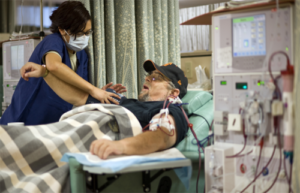The End Stage Renal Disease (ESRD) in the US is growing. Patents over 65 have the highest percentage of ESRD. Because of this, doctors are now trying to identify and treat the fact that elderly dialysis problems are on the rise.

Elderly Dialysis Problems on the Rise
Even though it helps, dialysis therapy is not the end all be all. In older patients, it doesn’t seem to preserve functional status or independent living. The most vulnerable time for older patients is when they first start the therapy.
Older patients that get hemodialysis (HD) show a high prevalence of functional disability and dependence.
The consequences of normal aging combine with dialysis side effects, like post treatment hypotension, increases the chances for falls. These falls can even cause accidental death.
The American Geriatrics Society recommends that all older patients be screened for falls. This empowers members of multidisciplinary dialysis teams to perform fall screenings and functional assessments. This is an easy way to identify patients who are at risk and increase their quality of life.
Many ESRD patients are also at risk for cognitive and executive function impairment. This can cause problems with complex thinking, compliance, quality of life, and decision making.
Time Limited Treatments
Because of the risk of further suffering from side effects in older patients getting dialysis, it’s important to check in with patients often. A time limited trial begins with identifying patient specific goals.
These are often tied to quality of life and geriatric syndromes, along with planned re-evaluations to assess the patient’s perceptions of the benefits and burdens of dialysis.
By talking about all this, it allows for a fluid transition into advance care planning. Advance care planning with dialysis patients can help promote the use of hospice, a benefit often that is usually not used with this group of people.
With advance care planning, there is connection to fewer intensive procedures at the end of life, death at the location of choice, increased patient satisfaction, and increased use of hospice.
More is being done to figure out what is best for patients and how to make it easier for both patients and their families.
Read more here.

